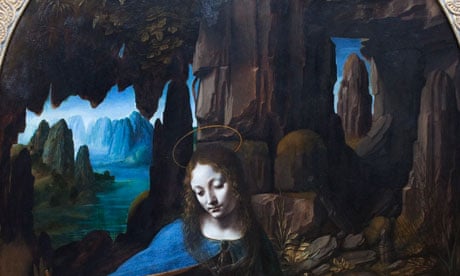I wonder if this is the place and the time to air my nuttiest speculation about Leonardo da Vinci. In my piece in today's paper about the restoration of his captivating altar painting The Virgin of the Rocks in the National Gallery, I argue that dream imagery and intimations of the unconscious are crucial to this painting's allure. Here, as a footnote, I'd like to suggest something more provocative about Leonardo as a religious artist.
In the first edition of The Lives of the Artists, published in Florence in 1550, the artist and critic Giorgio Vasari claimed that Leonardo da Vinci was a "heretic" who did not believe in God. In his second edition in 1568 he expunged this remark. But was it true? Da Vinci, as I mention in my book The Lost Battles, worried about the Pope's attitude to his anatomical researches, apparently aware that his notes in which he, for instance, casually speaks of humans' close relationship with other apes might not bear close clerical examination. Whereas Botticelli, a contemporary and rival, dedicated years to illustrating Dante's Christian poem the Divine Comedy, and Michelangelo wrote profound religious verse, there is not much in Leonardo's many pages of notes to suggest he was personally or introspectively Christian, although his science does postulate some kind of "prime mover" in the universe.
So what are we to make of his religious painting The Virgin of the Rocks? It has been suggested that perhaps the reason he had to repaint it was to clear up its potentially heretical imagery. Why is Saint John with Mary while Jesus sits apart? There was a heterodox theology that saw John and Mary as the true heroes of the New Testament, intercessors with the more remote Jesus. But then again, the cult of Saint John was central to Florentine popular culture so perhaps Leonardo is just reaching back to his own childhood experience of religious teaching – as an infant among the hills of Vinci.
My theory is much madder than that. It's just a wild thought. But look at the rocky pillar that towers up in the right background. We see it through a hole. A lot of other penetrable recessions appear in the painting – most strangely of all, the dark void at the heart of the figure of Mary herself. This was a painting for a fraternity dedicated to the Immaculate Conception of the Virgin Mary. Is there a graffiti artist's joke concealed in its phallic rocks and vaginal robes? Could Leonardo possibly be hinting that Mary's conception was less than immaculate, and she herself no virgin? Just wondering.

Comments (…)
Sign in or create your Guardian account to join the discussion